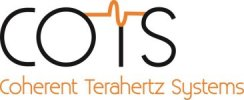About Terahertz Systems
The terahertz (THz) region of the electromagnetic spectrum (0.1 THz – 10 THz), with a bandwidth of approximately one hundred times greater than that occupied by all current wireless and broadcast systems, has shown enormous potential for a broad range of applications from healthcare to security, with communications, high resolution imaging (e.g. in the medical and pharmaceutical sectors), spectroscopic materials analysis and atmospheric sensing of special importance
However, to date realisation of this potential has been severely constrained by the technology available for the generation and detection of THz signals. The most widely available commercial systems are based on broadband generation using Ti:sapphire (femtosecond) pulsed lasers and photoconductive detector technology (the modern day equivalent of the spark transmitter and coherer detector for radio frequencies), resulting in large, power hungry (kW) and relatively insensitive systems. Whilst we anticipate that such systems will continue to find use in niche 3D imaging applications, where the high depth resolution resulting from the multi-THz bandwidth of the exciting signal is required, realisation of the full potential of the THz part of the electromagnetic spectrum will require a new approach, as proposed within this Programme.
The development of the radio frequency (RF) and microwave spectrum was made possible by the compactness, precision, spectral efficiency and sensitivity enabled by coherent techniques. In recent years coherent technology has also found renewed application in optical communication systems, where it permits the increase in spectral efficiency required to accommodate the rapid growth in internet traffic within the limited optical bandwidth available with current optical amplifiers. We assert that the introduction of coherent technology at THz frequencies will unlock the potential of this part of the frequency spectrum for both scientific and commercial applications. Such a development has long been prevented by the lack of cheap, compact, spectrally pure and power efficient sources. Semiconductor electronic sources above 300 GHz currently offer only very low few μW) output powers, the current room temperature operation record being 86 μW at 479 GHz from a third-harmonic mode InP Gunn effect device. This programme initiates a new approach to achieving the full potential of the THz spectrum by the use of photonic technologies first developed for optical communications to create compact, optical fibre interfaced, coherent Continuous Wave (CW) THz sources, on-chip sensors and receivers, offering unprecedentedly narrow linewidth and concomitantly improved detection sensitivity. In our work within the PORTRAIT project (EP/D502233/1) we successfully realised waveguide Uni-Travelling Carrier Photo-Diodes (UTC-PDs), which can be used to provide world record, room temperature, CW output powers at THz frequencies from semiconductor devices (150 μW at 457 GHz, 25 μW at 914 GHz) when driven with 1,550 nm telecommunications band signals. In parallel work, addressing frequencies beyond the likely upper frequency limit of UTC technology (2–3 THz), we have developed Quantum Cascade Lasers (QCLs) capable of CW output powers of>10 mW.
Currently QCLs require cooling, albeit to >77 K, have limited tuneability (<100 GHz) and spectral purity. However, in this Programme we will develop electronically tuneable and lockable QCLs which, together with our UTC-PD devices, will provide a coherent technology spanning the full range of THz frequencies that are of major applications interest (0.1 THz to 5THz). We will also develop room temperature photoconductive sources for use above 5 THz, albeit with limited output power, thereby bringing coherent technology to the entire THz spectrum.
